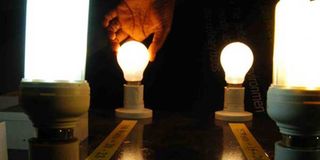WORLD OF FIGURES: Does it make sense to adopt LED lamps?

I am on an energy saving mission. The five most-used lights in my house are all 40-watt hot filament type. PHOTO/FILE
What you need to know:
- I have discovered that the prices of Light Emitting Diode (LED) lamps have dropped significantly enough to make economic sense.
- LEDs are more energy efficient than CFLs.
- While I needed a 12W CFL to replace a 40W filament bulb and get the same brightness; a 5W LED will give the same amount of light.
I am on an energy saving mission. The five most-used lights in my house are all 40-watt hot filament type. A few years ago, I had replaced them with Compact Fluorescent Lamps (CFL) but was disappointed by their lifetimes.
Even though CFLs are supposed to last about five to eight times longer than the filament type, mine had a much shorter life time. Considering that the price was about five times higher, the deal did not make sense; not to mention the inconvenience of changing bulbs every few weeks. The Kenya National Bureau of Standards must wake up and be more vigilant.
I have discovered that the prices of Light Emitting Diode (LED) lamps have dropped significantly enough to make economic sense. LEDs are more energy efficient than CFLs. While I needed a 12W CFL to replace a 40W filament bulb and get the same brightness; a 5W LED will give the same amount of light.
How do I know that? Well, brightness is not measured in watts. The watts only tell you how much energy the lamp will consume every time you switch it on. The amount of light it produces is given in lumens (lm). The number of lumens is usually written on the box carrying the lamp – look out for it next time.
A 40W filament bulb produces about 490 lm of light. You can get the same amount of brightness from a 12W CFL or a 5W LED lamp. The reason these newer technologies are able to generate more light is that they don’t do it through heating. They excite atoms and electrons directly without heating the material.
Changing from 40W to 5W will save 35W from each lamp; in total, the power consumption for these lights will go down by 175W.
Now these lamps are normally switched on at about 7 pm every evening and stay on up to about 11 pm when everyone has gone to sleep. That is, they are permanently on for about four hours every day or 120 hours per month.
To find out how much energy is saved, we multiply the power saving by the time in hours. That is, 175W x 120h = 21,000Wh. But electricity is sold in kilo-watt-hours (kWh) and one kWh = 1,000Wh. Therefore, I will save about 21kWh every month.
My most recent power bill shows that I consumed 284kWh for which I was charged Sh5,602. In other words, the average consolidated cost per unit (inclusive of all taxes and levies) was Sh19.72.
So, I expect to save about 21kWh x Sh19.72 = Sh414 each month. Is it worth it? Well, I paid Sh130 for each LED light; Sh650 in total. Therefore, they should pay back within a month and a half through saving.
The only question then is: will the LEDs last that long. Well, the box says that they have a 20,000h lifetime, so, ideally, they should live for the next 13 years. I will give you an update in the year 2030!
www.figures.co.ke; Twitter: @mungaikihanya




